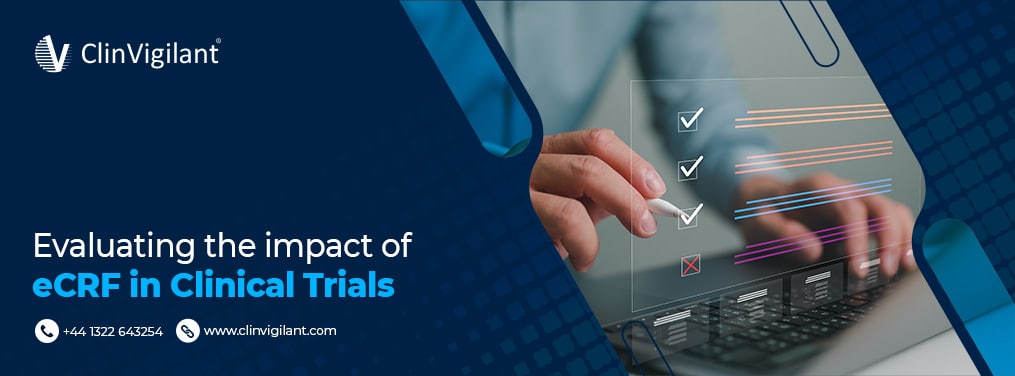
The introduction of Electronic Case Report Forms (eCRFs) as part of EDC Clinical Trials and Clinical Research has afforded researchers the opportunity to streamline data collection, making it easier to track patient information.
This new technology has enabled researchers to more accurately capture detailed information about patients and their conditions in clinical trials and research studies. However, it is important to evaluate the impact that eCRFs have on EDC In Clinical Trials and Clinical Research prior to further integration into research protocols.
This paper will discuss the advantages and disadvantages of using electronic case report forms for EDC studies, consider best practices for integrating them into research protocols, and provide recommendations regarding how best to evaluate their overall impact. It will also explore potential implications for medical ethics, patient privacy, and data security.
Finally, the paper will provide suggestions for how to ensure that eCRFs are used effectively in EDC Clinical Trials and Clinical Research. By exploring the various aspects of using electronic case report forms in EDC studies, this paper aims to provide researchers with a comprehensive look at the potential impacts that eCRFs can have on their research.
What are Electronic Case Report Forms
Electronic Case Report Forms (eCRFs) are forms used to collect and store data related to clinical research studies. They provide a structured way of collecting and organizing data about participants in the study, including medical history, lab results, treatments given, and other pertinent information. eCRFs can also be used for patient surveys or demographic information collection.
They provide an efficient way to capture detailed data from each participant while keeping track of all the required fields that must be collected for the study. Additionally, they allow researchers to quickly access needed information when it is time to analyze the results of their research. The use of these forms helps reduce errors due to manual data entry while providing more accuracy in reporting findings. By using electronic case report forms, clinical studies can be conducted more efficiently and accurately compared to manual data collection methods.
Furthermore, using eCRFs helps improve patient safety as researchers have access to updated information about each participant in the study. By having accurate information readily available, potential adverse events or drug interactions can be quickly identified and addressed before they become a serious issue.
How Electronic Case Report Forms Improve Efficiency and Compliance
Electronic Case Report Forms (eCRFs) are a convenient and reliable way to capture data in clinical trials. Unlike paper forms, which can be time-consuming and prone to errors, eCRF in Clinical Trials provide faster data entry as well as improved accuracy. This makes them an attractive option for streamlining the collection of clinical trial information.
Using Electronic Case Report Forms helps improve efficiency and compliance in many ways. First, they reduce data entry times by eliminating manual entry of data into multiple sources, thus freeing up resources that can be used for other tasks. Additionally, eCRFs provide real-time validation checks to ensure that only valid entries are accepted into the database. This ensures that investigators comply with protocol requirements while reducing errors due to human input.
Another advantage of eCRFs is that they enable better data visibility for stakeholders, such as sponsors and investigators. With an eCRF system in place, any changes made to the form can be seen by all parties at once, allowing them to quickly review and approve information. This helps reduce delays caused by communication issues and ensures compliance with regulations.
Finally, Electronic Case Report Forms streamline the process of monitoring the data collection process. Administrators are able to easily track progress on forms completion and response rates, which in turn helps ensure that data is collected in a timely manner while providing feedback loops for any areas where further improvement is needed.
How Electronic Case Report Forms Promote Collaboration Across Teams and With Partners
eCRF In Clinical Research are a convenient and reliable way to capture data in clinical trials. Unlike paper forms, which can be time-consuming and prone to errors, eCRFs provide faster data entry as well as improved accuracy. This makes them an attractive option for streamlining the collection of clinical trial information.
Using Electronic Case Report Forms helps improve efficiency and compliance in many ways. First, they reduce data entry times by eliminating manual entry of data into multiple sources, thus freeing up resources that can be used for other tasks. Additionally, eCRFs provide real-time validation checks to ensure that only valid entries are accepted into the database. This ensures that investigators comply with protocol requirements while reducing errors due to human input.
Another advantage of eCRFs is that they enable better data visibility for stakeholders, such as sponsors and investigators. With an eCRF system in place, any changes made to the form can be seen by all parties at once, allowing them to quickly review and approve information. This helps reduce delays caused by communication issues and ensures compliance with regulations.
Finally, Electronic Case Report Forms streamline the process of monitoring the data collection process. Administrators are able to easily track progress on forms completion and response rates, which in turn helps ensure that data is collected in a timely manner while providing feedback loops for any areas where further improvement is needed.
Consider the following guidelines when implementing Electronic Case Report Forms for pharmaceutical companies:
1. Utilize an intuitive electronic case report form (eCRF) design that is easy to navigate and understand. An eCRF should be organized in a logical manner, with fields clearly labeled and sections grouped together for easier data tracking.
2. Allow flexibility in the design of the eCRF to accommodate future changes or additions to the data collected during the clinical trial process. Any modifications to an existing eCRF should be tested thoroughly prior to implementation.
3. Ensure that all questions are relevant and necessary to answer the research objectives of the trial, as extraneous information should not be included in an eCRF. This will help keep data collection accurate and focused on only what is needed for the study.
4. Consider providing a preview of the eCRF prior to its implementation so that all stakeholders involved in the trial have an understanding of how data will be collected and reported. This allows for early identification of any issues or potential areas of improvement before the start of the trial.
5. Offer user-friendly training materials and support services such as webcasts, tutorials, and reference manuals to ensure that clinical research staff are comfortable with their eCRF and able to use it efficiently and accurately during their studies.
Conclusion
Overall, the implementation of eCRFs in EDC clinical trials and clinical research has been a great success. It has reduced data entry time significantly, improved data quality, minimized errors or omissions due to manual processes, and enabled real-time sharing of data between sites and sponsors. Additionally, it has drastically reduced paper usage and administrative costs associated with manual processes.
Ultimately, the use of eCRFs has led to more efficient monitoring visits and increased patient safety by providing an additional layer of oversight for clinical trial studies. By leveraging technology such as eCRFs, clinical researchers can improve study design accuracy and reduce study cost while still ensuring that all applicable regulations are met.
As such, the use of eCRFs should be strongly considered when evaluating data management solutions for EDC clinical trials and clinical research.

